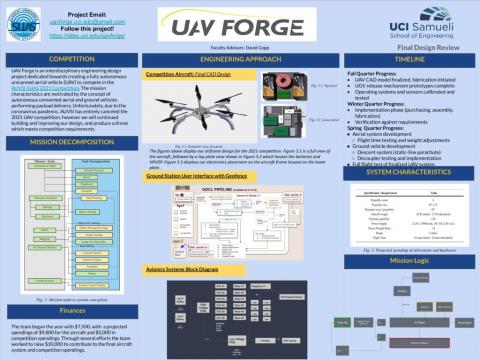UAV Forge
Background/Summary:
UAV Forge is a multidisciplinary engineering design project with a focus on designing, building, and programming unmanned aerial vehicles in order to complete the flight missions specified by the AUVSI SUAS 2021 Competition. Due to the coronavirus pandemic, AUVSI canceled the 2020-2021 UAV competition; however, UAV Forge decided to continue development using the same time constraints and mission needs. Since the construction of our UAV was already underway, we continued building and improving our design to produce a drone that meets competition requirements. Although we will not see it compete this year, we will have learned important lessons for the future and solved the intricate technical challenge.
The project had historically been a research project at UCI and has grown more popular over the years. Only recently has the project grown to encompass the competition aspect and grown our team to 60 members. With such growth came a remodel of the team's structure and organization to fully encompass the multidisciplinary aspects of engineering that the competition entails. As a team, we are composed of students from several engineering majors such as mechanical, aerospace, electrical, materials, and computer engineering.
This past year has been a new experience for all UCI engineering projects. UAV Forge worked hard to stay productive and work towards the completion of our aircraft. When lab access was limited or closed the team worked to design, safely manufacture, and test from home. Though this took a lot of logistical planning, the team was able to successfully assemble our aircraft by the end of Spring 2021.
Progress:
UAV Forge began the year with the decision to continue the design created from the 2019-2020 school year due to the lack of lab access from COVID-19. The team began with breaking down last year’s hexacopter multirotor design and identifying points that needed to be strengthened and those that did not need to be changed. Our mechanical engineering teams took this task on by closely following the engineering design process. The MAE teams came to the decision to keep the main body frame the same as last year's design and focus on other components. These components consisted of batteries to increase flight time, landing legs, motor mounts, camera mounts, electronics component placement, and ways to reduce the total aircraft weight through material selection. Over the past year, the MAE teams have worked effortlessly to complete each of these tasks which lead to our final full assembly of our multirotor.
Alongside our MAE teams, our EECS teams worked hard to create our autonomous systems, image recognition, obstacle avoidance, and main electrical connections. The hexacopter is controlled by a Flight Controller called the Hex Cube 2.1 (also known as the Pixhawk 2.1). The flight controller is running on Ardupilot, an open-source flight controller firmware. Our signal communication is handled by the sensor circuit which interfaces the 4 LIDARs and 4 Differential Pressure Sensors with the micro-controller. The LIDAR sensors will use UART communication protocol to transmit data, where it will then be used to move away from an object whether it is static or moving. To assist in calculating where to drop the UGV, we will attach four differential pressure sensors to the UAV and these sensors will be configured to act as wind sensors. Our image recognition was built from the ground up this past year and in the end, we were able to see the full functionality. Attached is a video link of our camera recognizing shapes, colors, and letters related to our competition guidelines: https://www.youtube.com/watch?v=X_xUWIq-Dsc
As a part of our competition guidelines, we are tasked with creating an unmanned ground vehicle housed on the underside of the aircraft that is capable of decent, autonomous driving, and carrying a water bottle. Our UGV subteam began the year with the development of the vehicle's mainframe and electrical components. Initially, the team decided to purchase a ready-made RC car and make adjustments from there to reduce weight. However, after several design choices, the team made the decision to design a body from scratch. Once the body was designed the team moved onto the decent portion. Descent by parachute was the final decision, as the team tested several different parachute descents and packing methods. With the body and parachute design complete the team moved to work on the autonomous features of the vehicle.
Future Plans
UAV Forge will continue working through the 2021-2022 school year under the guidance of a new leadership team. Next year's team has the goal of competing in the 2022 AUVSI Competition, with a newly designed aircraft. The team hopes to consider alternative aircrafts such as fixed wings, helicopters, and quadcopters as their competition aircraft. They also hope to work on research on the side to better develop certain aspects of the project such as path planning and image recognition.
By following a systems engineering design approach, our team aims to technical skills and learn more about the engineering process. Through inspiring innovation and teamwork between the different students in MAE, EECS, CPE, CSE, and I&CS majors, students are able to come out of the project with a broader knowledge of the different engineering fields.
Contact:
Email: uavforge.uci.sdp@gmail.com
Wesbite: https://sites.uci.edu/uavforge/
Instagram: @uavforgeatuci


